49 Breakup of the Mitsui Zaibatsu

Dismantling of Mitsui Honsha
On August 15, 1945, Japan accepted the Potsdam Declaration and surrendered, bringing World War II to an end. Immediately following the defeat, Mitsui leadership reportedly had an optimistic outlook for the postwar period. Criticized by the military and others for its pro-American stance and liberalism, and having a relatively weak defense industry sector, Mitsui appeared to view postwar reconstruction through peaceful industries as an opportunity to fully demonstrate its own capabilities.
However, shortly after the start of the Allied military occupation of Japan, the “United States Initial Post-Defeat Policy Relating to Japan” was announced, stating that it would “favor a program for the dissolution of the large industrial and banking combinations which have exercised control of a great part of Japan’s trade and industry.” It became clear that the General Headquarters of the Allied Forces (the “GHQ”) would proceed with the dissolution of these conglomerates. As a first step, the GHQ demanded the dismantling of the headquarters of each zaibatsu. Sumii Tokio, managing director of Mitsui Honsha, Matsumoto Kisashi (same), and Miyazaki Kiyoshi (president of Mitsui Bussan) sought ways for Mitsui Honsha to survive through reforms, including discussions with Colonel R.C. Kramer, chief of the GHQ’s Economic and Scientific Section (→Fig. 49b). However, the GHQ strongly insisted on the dismantling of Mitsui Honsha, notifying them that if they did not voluntarily decide to do so, the breakup would be enforced by order. Sumii came to the conclusion that the dissolution of Mitsui Honsha was unavoidable, and on October 22, 1945, he explained the situation at an urgent meeting of the Mitsui family and obtained the consent of the family for the proposed dissolution.
On November 6, 1945, the GHQ announced that the headquarters of the four major zaibatsu-Mitsui, Mitsubishi, Sumitomo, and Yasuda-would be dismantled “voluntarily.” In response, on November 8, Mitsui’s president Mitsui Takakimi (→Fig. 49c) gathered the employees of Mitsui Honsha and read a statement regarding its dissolution. On December 6, the company’s board of directors approved a number of resolutions, including the policy on the dissolution of the company, and initiated dissolution procedures, ceasing oversight of its direct and quasi-direct subsidiaries. Mitsui Honsha was dissolved on September 30, 1946, and the liquidation process began.
Dismantling of Ownership Structures and Personal Connections
Measures for dismantling of the zaibatsu were carried out on two fronts: the dismantling of ownership structures (family ownership, head offices, and affiliates) and the dismantling of personal connections.
On the ownership front, holding companies were the first to be dismantled. This included not only the zaibatsu head offices but was also aimed at companies with holding company-like characteristics; a total of 83 companies were designated. Within the Mitsui group, in addition to Mitsui Honsha, Mitsui Bussan, Mitsui Mining, Mitsui Chemical Industry, Mitsui Shipbuilding & Engineering, and Hokkaido Colliery & Steamship were all designated for dismantling. Of the 83 companies, 42 were dissolved and 41 remained. The designated companies transferred the shares they owned to the Holding Company Liquidation Commission, which was established in August 1946. Zaibatsu families also transferred shares they owned to the Commission. For the shares transferred by the designated companies and zaibatsu families, compensation was provided in the form of government bonds following disposal of the shares. The Holding Company Liquidation Commission prioritized selling the acquired shares to the issuing company’s employees, executives, and local stakeholders. It also disposed of shares through public auctions and sales to general investors and securities companies.
In terms of dismantling personal connections, members of zaibatsu families and individuals who held certain high-ranking positions in zaibatsu-affiliated companies were expelled from the business world.
The Impact of Capital Levies
As a result of these measures, the Mitsui family was completely severed from all relationships with Mitsui-affiliated companies, both in terms of ownership and human connections. Additionally, the Mitsui Family Meeting was dissolved, and the ties among the 11 Mitsui family branches were institutionally dismantled (→Fig. 49a).
For the Mitsui family, alongside the series of zaibatsu dismantling measures, the imposition of a capital levy dealt a devastating blow. These capital levies, aimed at the “sound distribution of national wealth,” imposed a maximum tax rate of up to 90% on assets as of a March 1946 survey. In the case of the Mitsui family, total taxable assets across the 11 family branches amounted to approximately 350 million yen, with an estimated tax rate of about 86%, with assets remaining totaling roughly 49 million yen.

Separate from the legal measures for dismantling of the zaibatsu discussed in the main text, the Mitsui Family Meeting also faced pressure from the GHQ to disband. The Mitsui Family Meeting decided to dissolve before an official directive was issued, and on July 16, 1946, it resolved to abolish the Mitsui’s House Constitution (→37) and dissolve the Mitsui Family Meeting. At the same time, the dissolution of the Mitsui Family Consortium, an organization aimed at preserving family assets, was also decided, bringing an end to the Mitsui system of shared property ownership that had continued since the early modern era. This resolution was passed by the heads of 10 of the 11 Mitsui families, as the Ipponmatsucho family had no designated successor following the August 1, 1944, death of Takateru, its second-generation head. Additionally, Takakane, the 11th generation of the Matsusaka family, was still a minor, so Takanaru of the Shinmachi family applied his seal on his behalf.

It is recorded that on September 27, 1945, Colonel Kramer of the GHQ’s Economic and Scientific Section, was invited to the Mitsui Annex in Mita Tsunamachi (now the Mitsui Club) for an initial meeting, a dinner party.

Second son of Takamine, 10th head of the Kita family. In 1933, amidst the turmoil of the “zaibatsu conversion,” he inherited the family estate following Takamine’s retirement, becoming the 11th head of the Kita family and president of Mitsui Gomei Kaisha. In 1944, he became president of Mitsui Honsha, leading the organization through the breakup of the zaibatsu.
